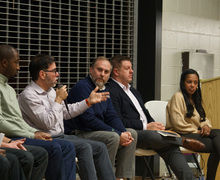Oregon State University officials study bones of extinct mammoth
Lindsey Leigh | Contributing Illustrator
Construction workers at Oregon State University uncovered the femur bone of an extinct mammoth under Reser Stadium.
Oregon State University may have to consider a mascot change — from the Beavers to the Mammoths — after construction workers unveiled the femur bone of an extinct mammoth during an expansion project of the Valley Football Center.
Steve Clark, vice president for university relations at OSU, said he was contacted immediately by Fortis Construction when the bones were uncovered. He said his next step was to contact Loren Davis, a professor in the anthropology department, and get him down to the site.
Davis, who said he gets these calls a few times per year, was hesitant to get his hopes up because often bones that are found aren’t as significant as people think they are, he said.
Despite his skepticism, as soon as he got the voicemail, he rode his bicycle down to the construction site where the workers were awaiting his arrival. Within a second of seeing it, Davis said he knew it was something very big and from an animal that was long extinct.
“That was absolutely surprising,” Davis said. “You don’t find extinct animals under football fields every day.”
Clark said the bones have resulted in international attention and news coverage, and added that OSU has been contacted by archeologists who are amazed at the discovery and would like to offer their assistance.
“Dr. Davis and his grad students are on site now, examining any additional areas needed. They are investigating everything,” Clark said. “It is of great importance to us to be very precise and thoughtful with this paleontological find.”
Sarah Skinner, a first-year graduate student in OSU’s applied anthropology program, has been involved with the identification of the bones that have been removed from the site. While analyzing the pieces, students try to identify what animal the bone came from and how they can piece them together, Skinner said in an email.
“Other archaeology graduate students and I were actually waiting for Dr. Loren Davis to show up for our weekly lab meeting. When he didn’t show up, we learned that he was helping to uncover mammoth bones at Reser Stadium,” Skinner said. “It’s not every day that, as students, we have the opportunity to help with a discovery and then have the ability to continue research afterwards.”
JD Lancaster, a second-year graduate student also in the applied anthropology program, has been actively involved with the entire project. Davis said Lancaster was the only graduate student who was with Davis on the first day at the construction site.
The opportunities to further their learning using remains of extinct animals, hands-on, has been quite advantageous, Lancaster said in an email.
“It’s hard not to learn a lot any time you work with Dr. Davis,” Lancaster said. “We’ve been discussing the context of the find quite a bit and I’ve learned a good deal about other megafauna finds in the Pacific Northwest, and how we can evaluate these finds for the presence of human artifacts or behavior.”
He added that through discussions about the context of the find, he has learned a lot about the stratigraphy and soils of Oregon’s Willamette Valley.
Lancaster also said he would have two focuses in terms of research and study moving forward. The first focus will be on how long ago the mammoth died, and the second on analyzing the environment of the location where the mammoth died.
“What this comes down to, is correlating the time that the mammoth died, with the variables contributing to the environment that was present at the time of the mammoths death, and using this information to find other locations in the area where similar finds might occur,” Lancaster said.
As for the future implications of the bones at OSU, Clark said they are beginning to have some serious conversations about what’s required to continue the research, how they are going to preserve the bones long-term and what ways they can display the bones for study and examination by others.
Published on February 4, 2016 at 12:06 am
Contact BreeAnna: blposhek@syr.edu





